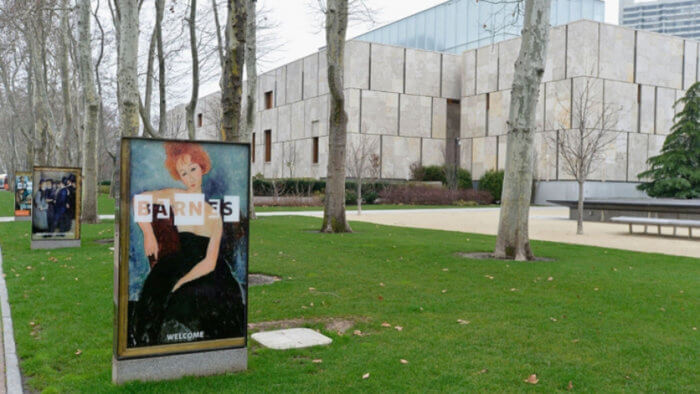
Through May 10, the Barnes pays homage to a little known pioneer in modern art and textiles, Marie Cuttoli, in ‘Marie Cuttoli: The Modern Thread from Miro to Man Ray.’
In 1930s France, the savvy art entrepreneur convinced leading modern artists of the time like Picasso, Miró and Braque, to translate their work to the tapestry medium — a revolutionary move in both art and business.
“Tapestry is a collaborative medium, an extremely expensive medium,” says exhibit curator, Cindy Kang. “An artist can’t just go into tapestry. There had to be a commission from the government or the state and the government was not approaching avant garde artists to do this type of work.”
Cuttoli, who was already a well-known figure in the art world through her gallery and fashion boutique Maison Myrbor, saw an opportunity to create something new in the art world that would benefit modern artists as well as weavers, who were struggling to find work during the Great Depression.
“It was well known that the weavers in Aubusson were out of work or working for reduced wages and this was close to her birthplace,” Kang says. “Cuttoli realized she could step in and be a broker between artists, workshops and clients to create this whole new product. She went back to her roots to help the weavers and put them back to work as well as advance modern art.”
Given that the world of tapestry was such an elite male art form makes Cuttoli’s success even more impressive.
“The government was not creating tapestry commissions during the Depression, so this was the time for her to do this,” Kang says. “Often in times of crisis, women have the opportunity to step into leadership positions and take charge.”
And with so many men off to war, including museum directors, a lot of the museums in the United States were being run by women.
“Many of these women supported Cuttoli’s work,” Kang says. “During WWII, Cuttoli’s tapestries toured to 21 different venues for six years.”
Dr. Albert Barnes was a big patron of her work as well.
“Dr. Barnes and Cuttoli were friends which is part of the reason we’re doing this project. He was a supporter and did a lot of behind the scenes work to help her,” Kang says. “The most interesting thing was when Germany occupied France in WWII and Cuttoli was seeking to flee to the United States, Dr. Barnes wrote her a letter of invitation which allowed her to secure a visa here.”
The exhibition has a number of highlights but there are two that cannot be missed.
“One of our Miró tapestries I was able to hang double-sided so you can actually see the back of the tapestry,” Kang says. “It shows you what the original, fresh, very vivid colors were and the technique. I was also able to reunite the tapestry with the original Miró painting that served as the model.”
She adds, “Another work that is really exciting is the tapestry by Man Ray that was thought to not exist but was rediscovered in 2016. I was able to reunite the whole project: the original rayograph, the blowup copy photograph that Man Ray used for the tapestry model and the finished tapestry.”
If you’re captivated by women who step up to change the world, even in times of uncertainty, a visit to ‘Marie Cuttoli: The Modern Thread from Miro to Man Ray’ will certainly inspire. While visiting physically may not be possible because of the COVID-19 pandemic, there is an exhibition book ($45) available for purchase on The Barnes website.
For more information, visit: barnesfoundation.org
































